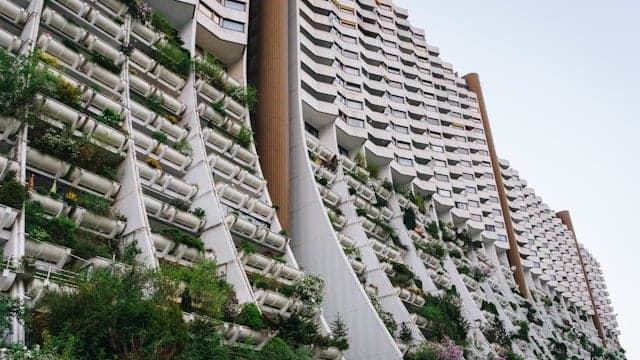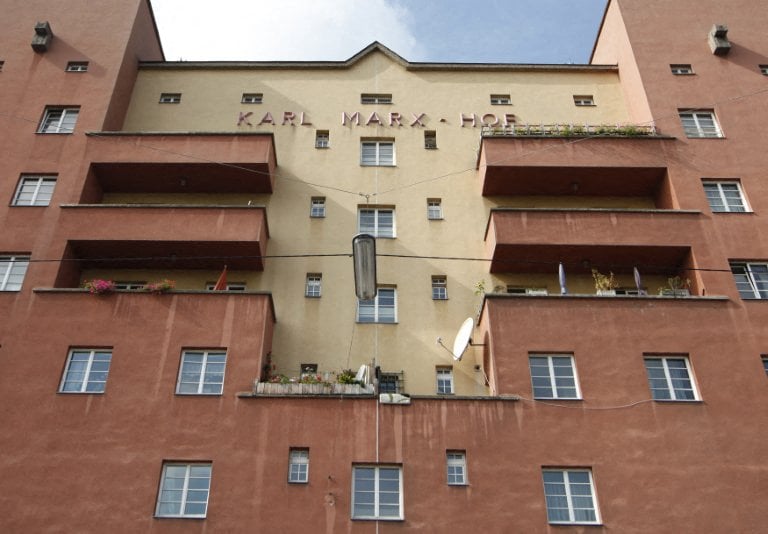Gemeindebau: How do you qualify for a social housing flat in Vienna?

Vienna is famous for its social housing system, which offers quality living at low rent. But how does it actually work, and who can get one of these municipal buildings?
Looking to move? Find your next rental apartment here.
Gemeindebauten, city-owned flats, are part of Vienna's social housing project and symbolise affordable and high-quality housing within the city.
The history of this type of municipal housing began in the 19th century when there was a large housing shortage in Vienna due to fast urbanisation and population growth. People moved to the city from other regions in search of job opportunities and better life quality. But instead, many of them ended up in overcrowded and poor housing situations.
The rapidly increased population was mainly affecting the working class and marginalised communities, who struggled to be able to afford decent housing. In response to this crisis, the newly elected Social Democratic city government began exploring solutions to make housing more accessible to everyone and initiated the "Gemeindebau" movement.
Today, Vienna is famous for its affordable social housing. More and less one in four flats in the city is a Gemeindebau, offering homes to around 500,000 people.
Benefits
While living in a Gemeindebau, you can enjoy low rent while being able to rely on the City of Vienna to take care of your flat and building. The rent is subsidised by the state, which also oversees all necessary functions such as management and renovations.
Gemeindebau also offers a social and inclusive living environment. The buildings are designed to encourage community involvement and often has green spaces, courtyards, playgrounds, and other communal areas such as small libraries or shared living rooms.
One of the main ideas behind Gemeindebau is to promote co-living with people from different background and create a more diverse and inclusive city. The buildings are found all over Vienna - and not limited to outer districts or lower-income areas - and integrate its residents to different areas where they normally have necessary services nearby the building, such as public transport, shops, healthcare facilities and schools.
Furthermore, the city of Vienna has during recent years focused on more sustainable and environmental housing. The have upgraded and set up energy-efficient heating systems, insulation, and renewable energy installations in many of their social buildings.
READ NEXT: How can I move into affordable cooperative housing in Vienna?
Downsides
Even if the concept of "Gemeindebau" offers its residents a lot of benefits, this type of housing also comes with some downsides. One issue is the limited ability, even if there are many buildings in Vienna, they are highly wanted and waiting times can be long.
Some social challenges can also be present, such as problems with creating a inclusive community among the residents and possible stigma around living in social housing. Even if the stigma is said to be little, it may sometimes still exist.
Residents might also have limited options and flexibility compared to those on the larger private housing market and need to rely on the state for running the buildings in good manners, something which could be an issue if policies of fundings change.
Furthermore, applying for social housing can be time-consuming and requires many steps, and you need to upload certain documents depending on your individual situation.

Karl-Marx-Hof is a famous Gemeindebau in Vienna. AFP PHOTO / DIETER NAGL (Photo by DIETER NAGL / AFP)
Who can get a Gemeindebau?
If you want to move into a Gemeindebau, you have to fulfil following criteria:
- Be at least 17 years old.
- Have lived for two years on the same address in Vienna registered as main residence.
- Be an Austrian citizen, Swiss citizens or EU/ EEA citizens, or have a recognised status of a refugee or a “Daueraufenhalt-EU", which applies if you are a non-EU citizen and have continuously lived in Austria for five years.
- Earn below a maximum income limit. (See the income limitations list here).
- Not have any ongoing legal issues or disputes related to renting or leasing a property.
- Have clarified family circumstances, which refers to being able to give information regarding family composition, married couples or persons in a registered partnership can only apply for an apartment together with their partner, for example.
In addition to this, you have to fulfil one of the following other criteria:
- Suffer from overcrowding where you currently live, with more people living in your flat than it is made for.
- Be subject to the setting-up-household rule (Hausstandsgründung), applicable if you are younger than 30 and have been living at your parents’ place for more than ten years.
- Be limited by special needs. For example, if you are older than 65 and receive care allowance (Pflegegeld) at the third care level or if you live in a flat below basic standards (such as without a toilet inside of the flat).
How do I apply?
If you want to register for a Gemeindebau, you can register online here. The city of Vienna also offers a short video explaining the different registration steps.
Furthermore, you book an appointment to get answers to questions you may have through the contact details here.
READ NEXT: IN NUMBERS: How much does it cost to live in Vienna in 2024
Comments
See Also
Gemeindebauten, city-owned flats, are part of Vienna's social housing project and symbolise affordable and high-quality housing within the city.
The history of this type of municipal housing began in the 19th century when there was a large housing shortage in Vienna due to fast urbanisation and population growth. People moved to the city from other regions in search of job opportunities and better life quality. But instead, many of them ended up in overcrowded and poor housing situations.
The rapidly increased population was mainly affecting the working class and marginalised communities, who struggled to be able to afford decent housing. In response to this crisis, the newly elected Social Democratic city government began exploring solutions to make housing more accessible to everyone and initiated the "Gemeindebau" movement.
Today, Vienna is famous for its affordable social housing. More and less one in four flats in the city is a Gemeindebau, offering homes to around 500,000 people.
Benefits
While living in a Gemeindebau, you can enjoy low rent while being able to rely on the City of Vienna to take care of your flat and building. The rent is subsidised by the state, which also oversees all necessary functions such as management and renovations.
Gemeindebau also offers a social and inclusive living environment. The buildings are designed to encourage community involvement and often has green spaces, courtyards, playgrounds, and other communal areas such as small libraries or shared living rooms.
One of the main ideas behind Gemeindebau is to promote co-living with people from different background and create a more diverse and inclusive city. The buildings are found all over Vienna - and not limited to outer districts or lower-income areas - and integrate its residents to different areas where they normally have necessary services nearby the building, such as public transport, shops, healthcare facilities and schools.
Furthermore, the city of Vienna has during recent years focused on more sustainable and environmental housing. The have upgraded and set up energy-efficient heating systems, insulation, and renewable energy installations in many of their social buildings.
READ NEXT: How can I move into affordable cooperative housing in Vienna?
Downsides
Even if the concept of "Gemeindebau" offers its residents a lot of benefits, this type of housing also comes with some downsides. One issue is the limited ability, even if there are many buildings in Vienna, they are highly wanted and waiting times can be long.
Some social challenges can also be present, such as problems with creating a inclusive community among the residents and possible stigma around living in social housing. Even if the stigma is said to be little, it may sometimes still exist.
Residents might also have limited options and flexibility compared to those on the larger private housing market and need to rely on the state for running the buildings in good manners, something which could be an issue if policies of fundings change.
Furthermore, applying for social housing can be time-consuming and requires many steps, and you need to upload certain documents depending on your individual situation.

Who can get a Gemeindebau?
If you want to move into a Gemeindebau, you have to fulfil following criteria:
- Be at least 17 years old.
- Have lived for two years on the same address in Vienna registered as main residence.
- Be an Austrian citizen, Swiss citizens or EU/ EEA citizens, or have a recognised status of a refugee or a “Daueraufenhalt-EU", which applies if you are a non-EU citizen and have continuously lived in Austria for five years.
- Earn below a maximum income limit. (See the income limitations list here).
- Not have any ongoing legal issues or disputes related to renting or leasing a property.
- Have clarified family circumstances, which refers to being able to give information regarding family composition, married couples or persons in a registered partnership can only apply for an apartment together with their partner, for example.
In addition to this, you have to fulfil one of the following other criteria:
- Suffer from overcrowding where you currently live, with more people living in your flat than it is made for.
- Be subject to the setting-up-household rule (Hausstandsgründung), applicable if you are younger than 30 and have been living at your parents’ place for more than ten years.
- Be limited by special needs. For example, if you are older than 65 and receive care allowance (Pflegegeld) at the third care level or if you live in a flat below basic standards (such as without a toilet inside of the flat).
How do I apply?
If you want to register for a Gemeindebau, you can register online here. The city of Vienna also offers a short video explaining the different registration steps.
Furthermore, you book an appointment to get answers to questions you may have through the contact details here.
READ NEXT: IN NUMBERS: How much does it cost to live in Vienna in 2024
Join the conversation in our comments section below. Share your own views and experience and if you have a question or suggestion for our journalists then email us at [email protected].
Please keep comments civil, constructive and on topic – and make sure to read our terms of use before getting involved.
Please log in here to leave a comment.